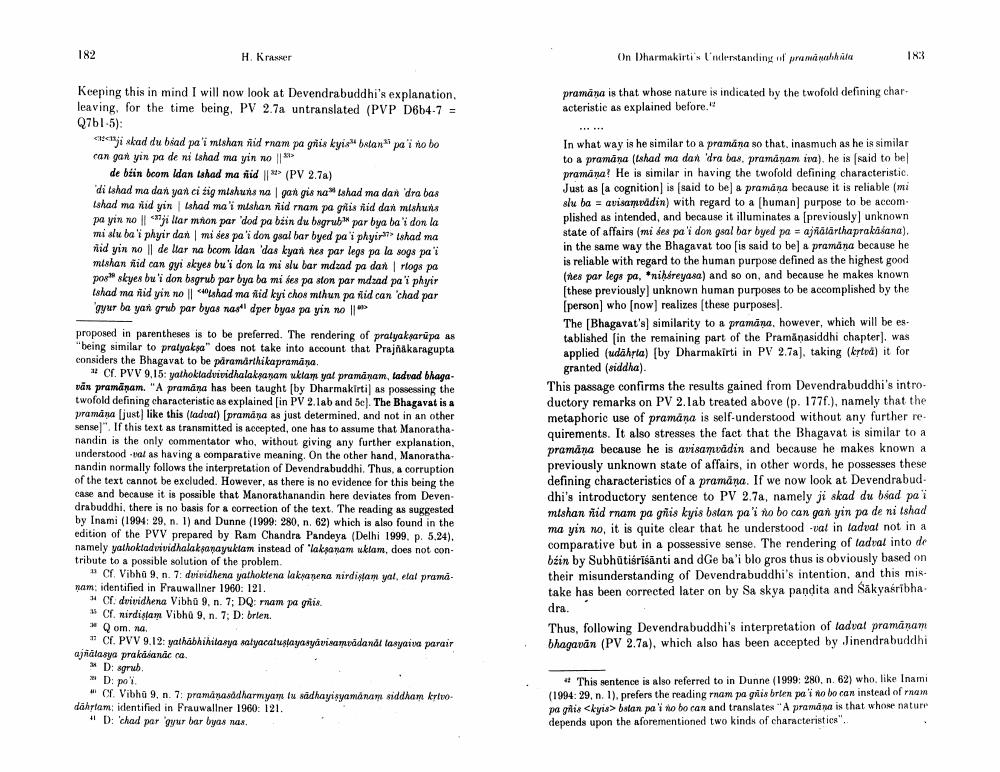Book Title: On Dharmakirtisunderstanding Of Pramanabhuta And His Definition Of Pramana Author(s): Helmut Krasser Publisher: Helmut Krasser View full book textPage 6
________________ 182 H. Kranser On Dharmakirtis muerstanding of proaminahala pramana is that whose nature is indicated by the twofold defining char acteristic as explained before." Keeping this in mind I will now look at Devendrabuddhi's explanation. leaving, for the time being, PV 2.7a untranslated (PVP D6b4-7 = Q7b1-5): 139i skad du biad pa'i mishan riid rnam pa griis kyix" bulan paino bo can gan yin pa de ni tshad ma yin no | *** de bain boom Idan tahad ma nid * (PV 2.7a) 'di tahad ma dan yan ci sig mishuns na gan gis na tahad ma dan dra bas Lahad ma nid yin shad ma i mishan vid ram pa gilis riid dan mishun pa yin no || jillar mon par 'dod pa bżin du bugrub par bya bai don la mislu ba'i phyir dan mises pa'i don geal bar byed pa'i phyirishad ma riid yin noll de llar na bcom Idan 'das kyar mes par legs pa la soge par mishan niid can gyi skyes buli don la mislu bar mdzad pa dan rloge pa por" skyen buli don bagrub par bya ba mi ses pa slon par mdsad pal phyir lshad ma rid yin no l shad ma flid kyi chos mihun perlid can 'chad par gyur bayan grub par byas nasi dper byas pa yin no 11" proposed in parentheses is to be preferred. The rendering of pratyakarüpa as "being similar to pratyaksa" does not take into account that Prajnakaragupta considers the Bhagavat to be paramarthikapramana. a Cf. PVV 9,15: yathokladvividhalaksanam uktam yal pramanam, ladvad bhagavan pramanam. "A pramana has been taught by Dharmakirti as possessing the twofold defining characteristic as explained in PV 2.lab and 50). The Bhagavat is a pramana ljust like this (tadual) pramana as just determined, and not in an other sense". If this text as transmitted is accepted, one has to assume that Manorathanandin is the only commentator who, without giving any further explanation, understood al as having a comparative meaning. On the other hand, Manorathanandin normally follows the interpretation of Devendrabuddhi. Thus, a corruption of the text cannot be excluded. However, as there is no evidence for this being the case and because it is possible that Manorathanandin here deviates from Devendrabuddhi, there is no basis for a correction of the text. The reading as suggested by Inami (1994: 29, n. 1) and Dunne (1999: 280, n. 62) which is also found in the edition of the PVV prepared by Ram Chandra Pandeya (Delhi 1999. p. 5,24). namely yathoklad vividhalaksanayuktam instead of 'lakaawam welam, does not contribute to a possible solution of the problem 1 Cr Vibha 9, n. 7: dvividhena yathoktena lakanena nirdistam yal, elal pramdnam: identified in Frauwallner 1960: 121. # C. dvividhena Vibhū 9. n. 7: DQ: mam pa griis 15 Cr nirdislam Vibha 9, n. 7: D: brlen. Qom. n. 12 C. PVV 9.12: yathabhihitasya salyacatuslagasyviamvadan tasyaiva parair ajñalasya prakāšanāc ca. D: sgrub. * D: poi # C Vibhu 9, n. 7pramanaddharmyam tuddhayisyemam siddham kru dahrtam: identified in Frauwallner 1960: 121. +1 D: 'chad par 'gyur bar byos mas In what way is he similar to a pramana so that, inasmuch as he is similar to a pramāna (Ishad ma dan dra bas, pramanam ira), he is said to be pramana? He is similar in having the twofold defining characteristic. Just as (a cognition is said to be a pramana because it is reliable (mi slu ba = avisamuddin) with regard to a (human) purpose to be accom plished as intended, and because it illuminates a (previously, unknown state of affairs (mi des pa'i don gsal bar byed pa = ajñalarthaprakišana), in the same way the Bhagavat too is said to be pramana because he is reliable with regard to the human purpose defined as the highest good (nes par lego pa, niháreyasa) and so on, and because he makes known [these previously unknown human purposes to be accomplished by the (person] who (now) realizes these purposes) The (Bhagavat's similarity to a pramāna, however, which will be es. tablished in the remaining part of the Pramanasiddhi chapter). Was applied (udahpla) [by Dharmakirti in PV 2.7a), taking (krtc) it for granted (siddha). This passage confirms the results gained from Devendrabuddhi's introductory remarks on PV 2.lab treated above (p. 1777.), namely that the metaphoric use of pramana is self-understood without any further re. quirements. It also stresses the fact that the Bhagavat is similar to a pramana because he is avisamvādin and because he makes known a previously unknown state of affairs, in other words, he possesses these defining characteristics of a pramana. If we now look at Devendrabud dhi's introductory sentence to PV 2.7a, namely ji skad du bead pai mishan nid rnam pa gilis kyis batan pa'i no bo can gan yin pa de ni Ishad ma yin no, it is quite clear that he understood -val in ladval not in a comparative but in a possessive sense. The rendering of tadval into de bzin by Subhatisrišanti and dGe ba'i blo gros thus is obviously based on their misunderstanding of Devendrabuddhi's intention, and this mis. take has been corrected later on by Sa skya pandita and Säkyasribha dra. Thus, following Devendrabuddhi's interpretation of tadual pramanam bhagavan (PV 2.7a), which also has been accepted by Jinendrabuddhi This sentence is also referred to in Dunne (1999: 280, n. 62) who, like Inami (1994:29, n. 1), prefers the reading rnam pa gris brien po' no bo can instead of ram pagilis <kyis> balan pano bo can and translates "A pramana is that whose nature depends upon the aforementioned two kinds of characteristics".Page Navigation
1 ... 4 5 6 7 8 9 10 11 12 13 14
